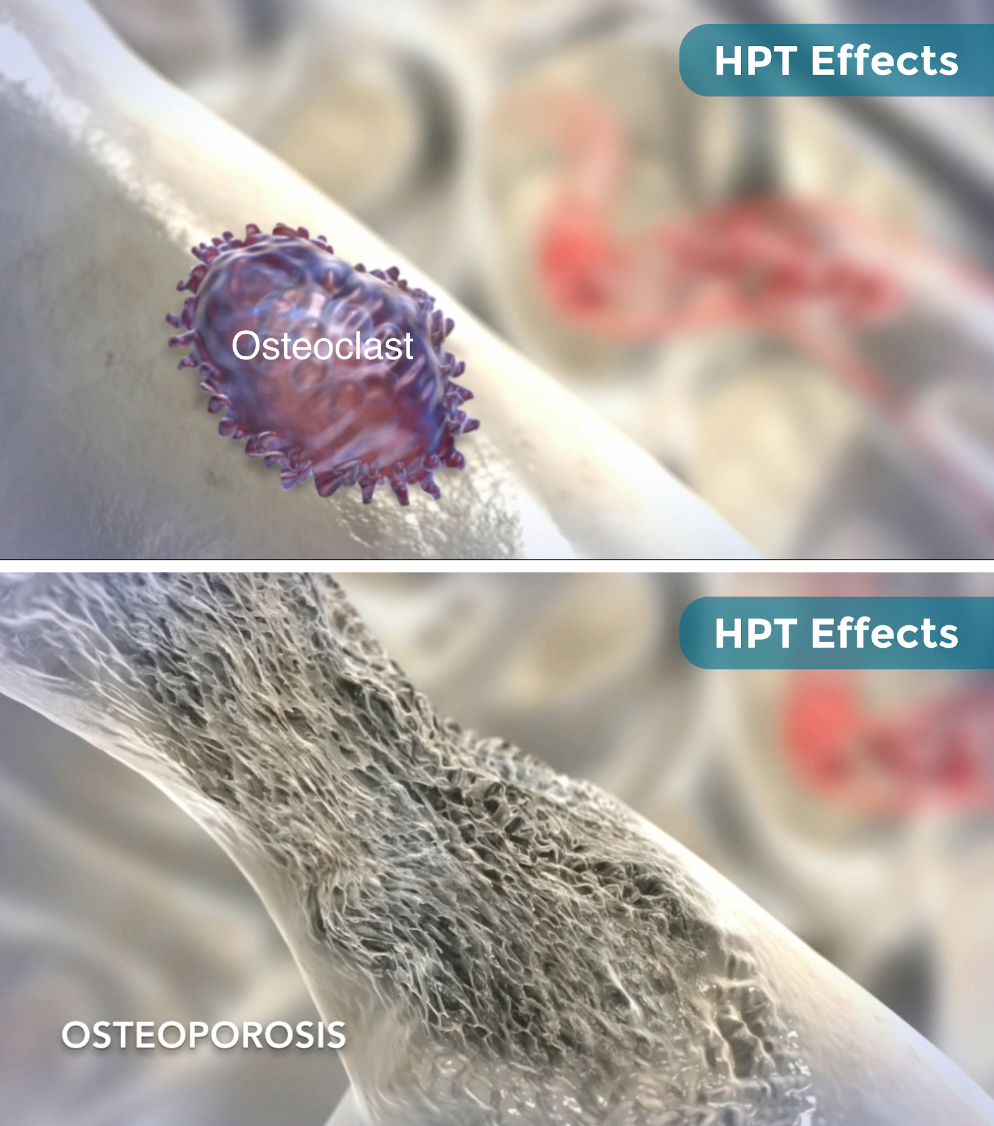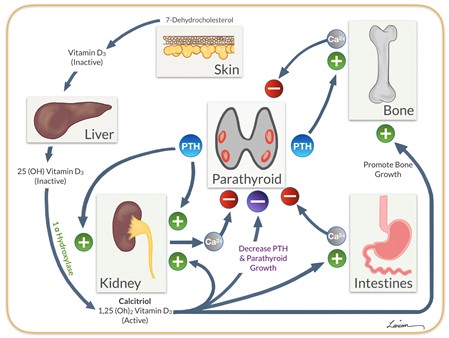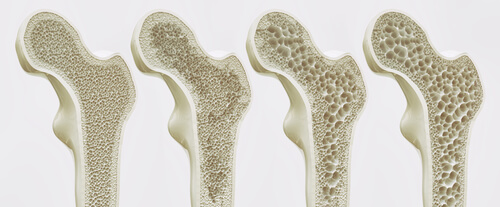Hyperparathyroidism (HPT) causes bone loss, which can lead to osteoporosis over time. Brittle bones and a higher potential for fractures characterize osteoporosis. There is no cure for the disease, but treatments are available to slow bone loss and reduce fracture risk. If hyperparathyroidism is present, hyperparathyroidism treatment is the priority to eliminate the primary bone loss cause.
Bone Remodeling, Hyperparathyroidism, and Osteoporosis
The link between HPT and osteoporosis can be traced to how bones develop. Bones begin as cartilage and harden after birth and throughout your life (ossification).
Every day, bones are broken down and replaced by two types of cells called osteoblasts and osteoclasts. Osteoblasts produce osteoid, new bone constructed from calcium, collagen, and fibrous protein. Osteoclasts are activated by the parathyroid hormone (PTH) and break down bone to release calcium into the bloodstream.

Can Hyperparathyroidism Cause Osteoporosis?
There is a direct link between abnormally high blood calcium levels and osteoporosis. Calcium is a vital nutrient that contributes to healthy bones. The parathyroid glands release PTH to boost blood calcium levels when they become low temporarily. PTH tells the bones to release more calcium into the bloodstream when levels decline. Once the calcium amount returns to normal, the glands stop producing PTH, and osteoblasts go to work, making the bones stronger again.

A benign tumor can form on one or more parathyroid glands, triggering the affected gland to secrete higher amounts of PTH continuously. Higher PTH levels break down bones, resulting in bone pain and weakening. The process can lead to osteopenia, which causes bones to become brittle. As osteopenia progresses, it can lead to osteoporosis. HPT creates high calcium and osteoporosis over time.
Everyone with hyperparathyroidism will experience some bone loss. If the disease goes unchecked for approximately eight years or longer, osteoporosis is likely to develop.
Symptoms of Osteoporosis from Hyperparathyroidism
Early symptoms of hyperparathyroidism and osteoporosis can be challenging to identify. Symptoms of HPT occur first and may include:
- Difficulty focusing
- Memory problems
- Ongoing fatigue
- Bone, joint, and muscle pain
- Digestive issues
- Increased thirst and urination
- Depression and anxiety
- Hair loss
These early symptoms are vague and may be attributed to many medical conditions. As HPT progresses, more symptoms can develop:
- Dehydration
- Nausea and vomiting
- Heart arrhythmias
- Elevated blood pressure
- Kidney stones
- Bone weakening, leading to osteoporosis
Bone pain and weakness are symptoms of hyperparathyroidism and osteoporosis. Additional osteoporosis symptoms include:
- Fractures, often in the hip or wrist, due to falls
- Compression fractures in the vertebrae
- Back pain from a broken or collapsed vertebrae
- Loss of height or poor posture
Diagnosing Osteoporosis in Hyperparathyroidism Patients
The diagnostic tests to identify osteoporosis and HPT include a blood test to evaluate PTH and calcium levels and a bone mineral density test to assess calcium amounts in the bone. High calcium and osteoporosis often indicate HPT is present. Your doctor may also request additional assessments to pinpoint your diagnosis and determine the safest, most effective treatment for you.
Diagnosing HPT
If hyperthyroidism and osteoporosis are both suspected, the HPT diagnosis should come first. HPT treatment can stop and even reverse some bone loss. If HPT isn’t treated, osteoporosis treatment won’t be effective since PTH and calcium levels will remain abnormal.
A correct hyperparathyroidism diagnosis depends on your doctor’s understanding of the relationship between calcium and PTH levels. Normal parathyroid function regulates these two levels, so when calcium is low, PTH is high since the parathyroid gland produces PTH to release calcium into the bloodstream. When calcium returns to normal, PTH production shuts down, and PTH levels decline.
A patient with classic HPT will have high calcium and PTH levels since the PTH releases calcium even when enough is in the bloodstream. However, some HPT patients may have an average calcium level with a high PTH (normocalcemic HPT). Others could have high calcium levels with normal PTH (normohormonal HPT).
Normocalcemic and normohormonal HPT are more challenging to diagnose and typically require additional testing. A doctor specializing in diseases of the parathyroid gland will have the expertise to know when to perform more tests to arrive at an accurate diagnosis.
Diagnosing Osteoporosis
High blood calcium levels and osteoporosis often occur with hyperparathyroidism. A bone mineral density test shows that while blood calcium may be high, calcium in the bone may be low. DEXA scan measures calcium and other mineral amounts in a portion of your bone. Testing is usually done on the spine or hip, but also should include the forearm. Low mineral amounts indicate osteoporosis is developing or already present.
When to Consult Your Doctor About Hyperparathyroidism and Bone Health
An accurate HPT diagnosis and treatment are the first steps in maintaining bone health and preventing osteoporosis. If HPT remains unchecked, the parathyroid will continue to produce high blood calcium levels, and osteoporosis is more likely to occur.
After an HPT diagnosis, scans like an ultrasound or 4D parathyroid CT scan identify the precise location of the tumor. These tests also determine how many parathyroid glands are affected. Your doctor can remove the tumor or the defective parathyroid gland to reverse parathyroid disease. After successful HPT treatment, bone density levels are likely to improve. Lifestyle changes like a diet rich in vitamin D and calcium and a daily exercise program will also help keep bones strong and healthy.
Dr. Babak Larian of the CENTER for Advanced Parathyroid Surgery in Beverly Hills offers a minimally invasive parathyroidectomy (MIP) to treat HPT and osteoporosis. He performs an MIP via a small incision into a patient’s neck. The procedure usually takes about 20 minutes to complete. It has a high cure rate and causes less scarring than traditional parathyroid gland surgeries.
To learn more about minimally invasive parathyroid surgery for HPT and osteoporosis or to request a consultation with Dr. Larian, please get in touch with us online or call us today at 310-461-0300.










